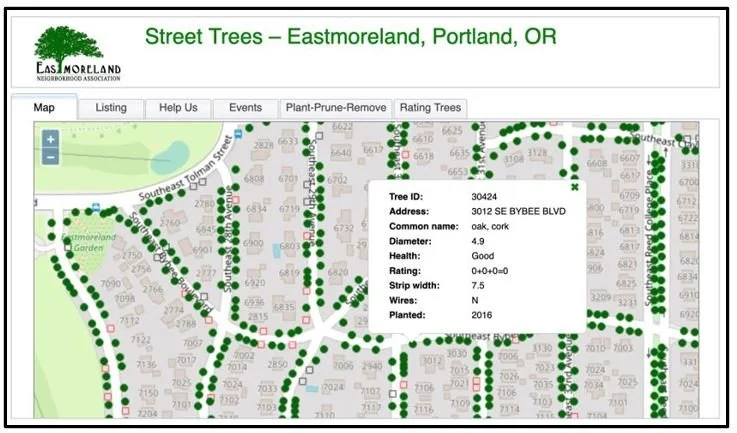Tree Committee
Eastmoreland is a neighborhood defined by its beautiful tree-lined streets. Our neighborhood owes its lush and serene beauty to the large canopy of trees planted by generations of homeowners like you. Each tree is a testament to individual homeowners, who over time have cared for the well-being of our beautiful community of trees.
MISSION STATEMENT
The Eastmoreland Tree Committee envisions a neighborhood where residents work together and cooperate with conservation groups and city bureaus to maintain an evolving, verdant, healthy, and beautiful neighborhood landscape unified by trees. The Tree Committee recognizes the importance of a healthy tree canopy for the enjoyment of the residents and to mitigate climate change. Our goals and objectives are here.
TREE COMMITTEE CONTACT INFORMATION
Event announcements are made on the ENA website. The Tree Committee, a standing committee of the ENA, meets as needed, with monthly meetings currently scheduled on the First Monday of the month. The current co-chairs of the tree committee are Jerry Beatty and Matt McGraw. They can be reached at: eastmoreland.tree@gmail.com.
PLANTING PROGRAM
Beginning in 2020, the ENA Tree Committee has helped homeowners in Eastmoreland plant street and yard trees. They work with a local wholesale nursery to obtain the trees selected by the homeowner. The tree order is finalized with the nursery in mid-fall and planting occurs in the winter (late December or January). Interested homeowners are encouraged to contact the Tree Committee in the summer or early fall. The committee sends email reminders throughout the year about ordering trees, preparing planting sites, watering, mulching, and pruning.
The link for street tree ordering and permitting is here
The link for preparing for your new tree is here.
The ENA pays the nursery for the trees and planting them. Homeowners, in turn, are requested to make a financial donation to the ENA which allows the association to continue to support the purchase of trees each successive year.
The ENA has helped plant 103 street trees and 12 yard trees since 2020 ranging from Ash, Elm and Dogwood to Ironwood, Oak, Maple and Zelkova! Click here to see the numbers and kinds of trees planted by the ENA since 2020.
TREE CARE
Each homeowner, by city code, is responsible for the care and maintenance of the street trees in front of their property–the trees in the public rights of way, the planting strip between the sidewalk and street.
Water young trees weekly during the dry months (June through September) for the first five years to help them get established. This is critical to their survival.
Water mature trees during dry months every 2-3 weeks.
Remove grass and add several inches of mulch around your trees. This helps conserve soil moisture and it also prevents lawn mowers and string trimmers from damaging the tree trunk.
Remove branches that are broken or obstructing the sidewalk or street right-of way. The city requires sidewalk clearance of 7 ½ feet, street clearance of 11 feet, and arterial clearance of 14 feet. Removal of branches over ½” in diameter or complete tree removal requires a permit from the City. See https://www.portlandoregon.gov/trees/ for permit requests.
Remove dead, dying, or dangerous trees.
Tree care links:
STREET TREE INVENTORY
In 2011, Eastmoreland's street trees were inventoried by Urban Forestry staff with the help of many volunteers. Since then, the Eastmoreland Tree Committee has updated the inventory periodically with plantings, removals, and condition ratings. Our information is available in map and list form at ena-streettrees.info.
What can you do with the website other than check the information on your trees?
Bookmark the site on your phone's home page. Now, if you're out for a walk and want to identify a street tree, you can use your phone. There's a button for zooming in to your approximate location on the map.
If you are thinking about a new street tree and you want to check on recently planted ones, such as willow oak, go to the List tab and enter willow, and a list of the current number of willow oak street trees in the neighborhood will be shown.
If the map shows a vacant spot in front of your house and you plant a tree, tell us about it on the Help Us tab.
If you're just interested in numbers, such as how many American elms were present in 2011, have been removed, and are still remaining, you can get that info from the List tab. The counts as of spring 2024 were 237, 118 and 119, respectively.
WAYS TO HELP EASTMORELAND TREES
1. Plant trees in any open street tree spaces. There are nearly 700 empty spaces for trees of various sizes in Eastmoreland!
2. Volunteer with the ENA Tree Committee. We are always looking for help to increase neighborhood engagement on our trees.
3. Contribute to the ENA Tree database: Submit information about a large limb or whole tree failure by going to http://streettrees.eastmorelandpdx.org. At this website you can also learn about the condition, genus and species of any neighborhood street at any neighborhood address.
TREE RESOURCES
Permits: When a permit is required to large branch prune or tree removal or to make informed decisions on a street tree , go to https://www.portlandoregon.gov/trees/ or call 503-823-4489.


